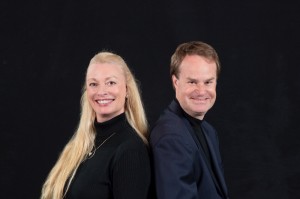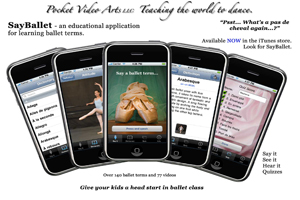Today we have an interesting feature for 4dancers readers–the team behind the “SayBallet” app answers questions about the process of going from the idea to the finished product….
1. Carol, what is your background in dance?
My name is Carol Richmond and I am the Director of the Carmel Academy of Performing Arts. The Academy is located in downtown Carmel, California and was built as a dance studio by the late Joanne Nix in 1954. I bought the studio in 1989. Currently we have 35 teachers on staff and teach ballet, tap, jazz, modern, contemporary, voice, drama and all musical instruments. I was originally trained in ballet by Billie Jacobson, a Chicago Opera Ballet dancer turned teacher. My true formative years in dance were in Texas studying with Doria Avila, a retired Broadway choreographer whose claim to fame was being Judy Holliday’s partner in many Broadway productions. He formulated my belief there was a big world out there and I was going to get out of South Texas and see it! I attended the University of Texas at Austin and studied under Ygor Youskevitch, a tough taskmaster. I auditioned for the San Francisco Ballet and was cut while doing plies at the beginning of the class by one of the Christensen Brothers and that began a 5 year hiatus from dance. After moving to Carmel, I connected with Mrs. Nix who owned the studio I now own. She taught me how to teach and I found I loved working with young people. That was in 1978. The rest, as the say, is history.
2. Can you tell me what SayBallet is and who it is designed for? (Carol)
SayBallet is designed for the teacher or the student. I found after years of teaching, I am not able to demonstrate the way I did years ago. For me, the app is a teaching tool for the classroom. For the student, it is a way to not only hear the french terms stated, see what the terms mean, but be able to study how the step is performed.
3. How did the idea for this app come about? (Carol)
Phillip Corrigan, the software designer that created the app, came to me with another idea for a fundraiser for the non profit dance organization I founded. It was a great idea about a photo of the Nutcracker that people could download for .99 as a screen saver. One thing lead to another, I talked about flashcards I had created five years ago for classroom study…and Phillip thought the flashcards could be beneficial to students and teachers in an app form.
(Phillip) I see a future where more and more Internet access and personal computing functions are delivered on small portable personal devices. Apple, with their iPhone, is the first company to deliver a product that is not only a powerful computer in the form-factor of a phone, but is also very enjoyable and easy to use. Apple’s revolutionary touch interface is one of the keys to the iPhone’s incredible success. I believe that the touch interface and the simplification of the user’s interaction with the device (i.e. users don’t have to know and worry about file systems, users don’t have to follow complex software installation processes, etc.) will also make the Apple iPad a very successful product. These two products are ushering in a new era of personal computing.
But beyond the technical merits, over 90% of the younger generation prefer the iPod (and the convenience of the iTunes music store) over all other MP3 music players. This generation is purchasing the iPod Touch (if they can afford one) and later migrate to the iPhone, because they already have an investment in iPod Touch/iPhone app software (not to mention their iTunes music library).
To-date over 75 million iPod Touch/iPhones have been sold worldwide in 98 countries. And that number continues to see enormous growth while competing smartphone product sales are either stagnating or seeing declines. Two years ago, the smartphone market in the US was dominated by 33% RIM Blackberry, 33% Microsoft Windows Mobile, and 33% Palm. Today, the market is 33% RIM Blackberry, 20% Apple iPhone, and 10% Android.
4. What are the features of the app? (Phillip)
About the app: The majority of kids prefer to play games on their devices, but I see an opportunity to create fun-to-use educational applications. The SayBallet application was originally conceived as a flash card application for learning the French ballet terms. I had spoken with ballet instructors and repeated heard that they wished their students would learn the ballet terms outside of class, so that they could focus dance inside of class. During the course of our development, the app morphed more into a multimedia reference glossary of ballet terms. Students can:
– Search for a ballet term
– Read a description
– See a video or picture of the movement or position
– Hear the term properly pronounced
– Practice saying the term (with voice recognition)
– Take a quiz to test their knowledge of the terms
5. How difficult was it to develop the app? (Phillip)
I have 20 years of computer software development experience. For me it is not that difficult, but there is a learning curve – I had spent a year (part-time) learning to develop applications for the iPhone. The actual application took about 6 months to develop (again, I did this in my spare time). Our follow-on apps, SayTap and SayJazz will probably take around 3 months to complete (one month if I could afford to work full time on the projects). To be successful as an app, the software must not only be functional, but also look fantastic – a lot of time and effort must be invested in design. There are over 150,00 apps now available in the iTunes App Store – in order to be noticed by consumers, the app must be designed very well.
The international market for apps created by Apple, is also unique. From the beginning, I designed the app to be used by international users. I translated the app into 10 languages. To-date, we have had sales in 31 countries. Prior to the iPhone and the iTunes App Store, it was inconceivable for me, as an independent software developer, to be able to independently publish a software application and have sales in 31 countries within the first 3 months.

6. Are you planning other apps in the future for dance, and if so, what are they?
We are currently in production for SayTap, SayJazz, SayHipHop and all 10 of the ballroom dances.
7. Do you work with others who have ideas for dance apps, and if so, what are you looking for?
It would be of great interest to work with others with ideas we have not yet approached. Both Phillip and I are open to interest and look forward to other opportunities to create teaching tools for educational dance/music products.
8. How has this app been received thus far?
The app has been a huge success, with sales in 31 countries. We expect our follow-on dance application to experience similar sales. Our big challenge is marketing – with over 150,000 applications available in the iTunes app store, it is difficult to get noticed. But with the email flyers that we send out, we are experiencing constant daily sales. With more dance apps in our portfolio, we expect to eventually grow brand awareness. Additionally, every year a new group of students start dance instruction. And every year the adoption of the iPhone in this market demographic increases.
9. How long did it take to develop the app from the idea to the finished product? (Phillip)
It will probably take around 3 months to finish SayTap and SayJazz. We also have SayHipHop and the ballroom dances lined up as well. I’m trying to also add new features to the application so that users will be attracted to using it more often. Currently, I hear that very young children love watch the videos over and over again. Older students probably only use the application occasionally. Experienced students may look at the application once or twice. I’m trying to design features and learning tools that will attract students to use the application more frequently. I’m also investigating adding social networking features into the app.
10. What has been the best part of the process for you both?
Carol:
The best part for me is the knowledge that this app can create another avenue of learning for young people interested in dance. I believe in a solid, technical base of study, terminology, and understanding the basics is vital to the 2010 dancer that must be well versed in not only ballet but all of the other styles of dance and music.
It has also allowed me to grow as a teacher and mentor to young dancers. Phillip has created an opportunity for me to learn (a little bit!) about an area I didn’t know anything about! His “detail oriented” personality and my “big picture, let’s go for it” attitude seem to create a great product!
Phillip:
For me the process is a lot of fun. I enjoy working with our young dancers. I learn a lot about different forms of dance. My daughters and wife are all interested in dance, so they take an active roll in the design process. Programming the iPhone (and iPad) is a challenge and a lot of fun. I also find the business aspects of creating and marketing a product, building a business, and interacting with an international customer base very enjoyable.
The cost of this ap is $4.99






